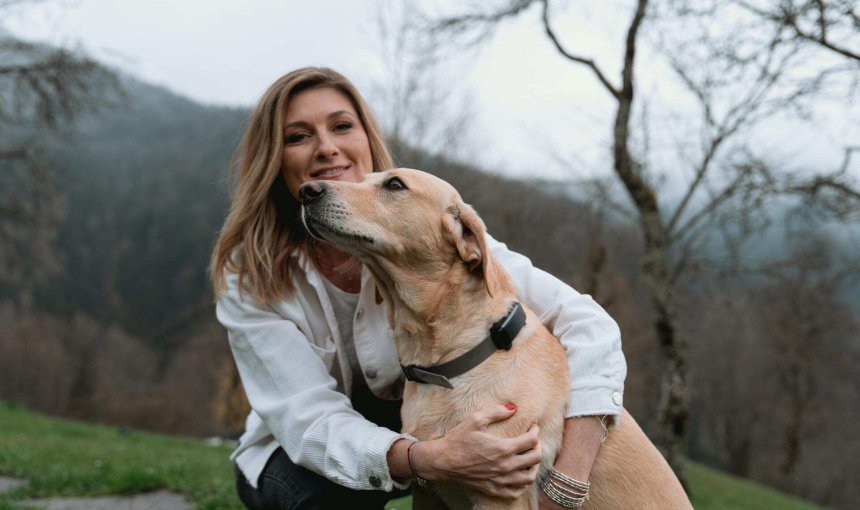 Approved by Dr. Dwight Alleyne, DVM
Approved by Dr. Dwight Alleyne, DVM How To Manage Separation Anxiety In Dogs
Short of being another aww-inducing scenario, separation anxiety in dogs is actually a serious condition. In some cases, your dog might even run away from home due to it! So here's how to manage it & understand it best.

For some dogs being home alone can be scary – which might come out as destructive behavior. So if you’ve found yourself coming home to a mess, claw marks on your furniture or window sills, or your buddy peeing all over the place…you might be dealing with a case of separation anxiety. Here are a couple of steps you can take to better understand this condition. (And where a Separation Anxiety Monitor for dogs can be a lifesaver.)
Key Takeaways
🏠 What it is: Separation anxiety is a condition where dogs panic when left alone, often showing distress through barking, whining, or destructive behavior.
🐶 Common triggers include changes in routine, a new home, or loss of a companion.
😔 Warning signs include clinginess, pacing, accidents indoors, escape attempts, and anxious behaviors when you prepare to leave.
🤗 How to help: Gradual desensitization, keeping departures low-key, using puzzle toys, and crate training can reduce anxiety over time.
🌎 A smart dog tracker with a built-in Separation Anxiety Monitor lets you keep an eye on your dog’s behavior and activity while you’re away, helping you assess their well-being remotely.

Always know your buddy is healthy & safe
Read moreWhat is separation anxiety in dogs?
Separation anxiety is a feeling some dogs get when they get separated from their owner, the people they’re attached to. It’s a pet’s exaggerated fear of separation. Once you’re home, you might find your dog excessively clingy – following you around everywhere (even to the bathroom!) However, this condition commonly results in destructive and inappropriate behaviors when you leave your dog at home alone. Including:
- Upturned or destroyed furniture
- Digging around your house, including indoors
- Chewed up slippers or other household items
- Peeing or pooing indoors
- Pacing up and down
- Excessive shaking and/or panting
- Scratched furniture, doors, or window sills
- …or a ton of messages from your neighbors, complaining about their barking, whining, and howling.
Typically, separation anxiety and distress behaviors occur during the first hour of being alone or when their owner prepares to leave. Some dogs might even try to prevent you from leaving the house – or seem depressed right before you leave.
⚠️ Other dogs with separation anxiety may even attempt to escape home (likely to find you!)
“A dog with separation anxiety might try to escape from an area where he’s confined when he’s left alone or separated from his guardian.
The dog might attempt to dig and chew through doors or windows, which could result in self-injury, such as broken teeth, cut and scraped front paws and damaged nails.”
– ASPCA.org1

Follow your dog anywhere
Get real-time location information, wherever they go. And find out when they try to make an escape, or just when they go somewhere they shouldn’t, with Virtual Fences.
What may cause separation anxiety in dogs?
It’s not completely understood why some dogs suffer from separation anxiety and others don’t. Rather, a whole bunch of factors may cause this condition. Here are some of them:
- Traumatic past experiences, like being separated too early from Mama dog, violence or abuse, being lost in unfamiliar surroundings, losing a family member (or fellow pet), and even experiencing a big, stressful change.
- Some dog breeds with more “people pleasing traits” might develop separation anxiety if you leave them alone for too long. Other, more high-energy dog breeds might grow bored and restless without a job to keep them busy or company.
- Ageing might put your dog at risk of cognitive decline, especially if you don’t keep them mentally active. Likewise, your senior dog might also be losing their senses (like their hearing, vision, or balance) or experiencing mobility-affecting conditions, like arthritis. All of which can be scary to experience – so your dog might grow more clingy with age as they look to you for comfort and support.
Dog breeds that may be prone to separation anxiety
- Golden Labs and Retrievers
- German Shepherds
- Cocker Spaniels
- Chihuahuas
- Border Collies
- Yorkshire Terriers
- Viszlas
- German Shorthaired Pointers
- Poodles
- Bichon Frises
How to handle separation anxiety in dogs
Now the whole point of preventing separation anxiety in dogs is to help them understand: it’s okay if you leave home, you’re going to come back! Which begins with training them to associate you leaving home = something good. (And not the end of the world.)
Keep your dog occupied at home
- Practice gradual departures
Start by leaving home for a few minutes and (very) gradually increasing the length of time. Give your dog a ton of pets and praise once you do return. - Make sure your dog’s home environment is an enriched one
With plenty of toys, treats, food puzzles, and other tools to keep them occupied. - Invest in chew toys
Chewing is a great stress reliever for dogs and provides your pup with a strategy for calming down. - Hide small treats around the house or in the crate
This keeps your dog busy and out of boredom. - Tire out your dog before you leave
Give them plenty of physical and mental exercise, and quality time with you. When you then leave, they’ll be more content to sleep or just take it easy. - If your dog’s anxious behavior has gotten worse over time, get in touch with your vet
They can help you best understand whether your dog might need medication to cope with their anxiety or try some other treatment method.
Give your dog a little company
- Invest in a dog sitter
Maybe a family member or neighbor to come sit with your dog while you are away. Else, check out your local boarding facilities, kennels, or doggy daycares near you. - Arrange a play-date
Maybe one of your dog-friends from the local park wants to bring your dog for a walk as well. - Consider getting another pet
If you’ve thought about adopting a new family member, it’s a great way to see if a second dog could help the situation.
Plan ahead for an escape attempt
If they’re old enough, getting your dog microchipped is always a good idea. A microchip works like a permanent ID tag for your pets – and a vet or local shelter can scan it to find your contact details and inform you they’ve found your lost dog. Likewise, we’d also recommend you inform your neighbors and loved ones well in advance, so they can keep an eye out for any escape attempts.
Use a Separation Anxiety Monitor
Strapped to their collar, your trusty Tractive GPS both monitors your dog’s movements – and helps you pick up on any signs of anxiety. Like, for example, if your dog is barking more than usual, which you can pick up with your tracker’s built-in Separation Anxiety Monitor. You can also monitor your dog’s vital signs, like their breathing and heart rate – and pick up on a change earlier.
While some dogs bark a lot, and some less, pet owners need to be aware of changes. If your dog suddenly starts barking more or less than usual, it could be a sign that they’re in pain or distressed.
– Dr. Dwight Alleyne, DVM
But once you’ve switched on your tracker’s Separation Anxiety Monitor before you leave home…

…it sends you an alert if it picks up on a weird increase in your dog’s barking or movements. All of which could signal anxiety or distress. So you can call a neighbor to check in on them – and hopefully prevent an escape.
Your furry friend’s health and wellbeing means as much as to us as it does to you. So we’ve made it a priority to only share medically-relevant content on our blog. This post was checked, double-checked, and medically verified by Georgia-based vet, Dr. Dwight Alleyne.

Dr. Dwight Alleyne, DVM
Originally from Long Island, New York, Dr. Alleyne began his career at a no-kill animal shelter before becoming a licensed veterinary technician. He graduated from Cornell University Veterinary College in 2006 and completed an internship at Purdue University. Now practicing in Georgia, Dr. Alleyne specializes in soft tissue surgery and ultrasounds. He also writes pet health articles on his website, “The Animal Doctor Blog” (www.anmldrblog.com).



